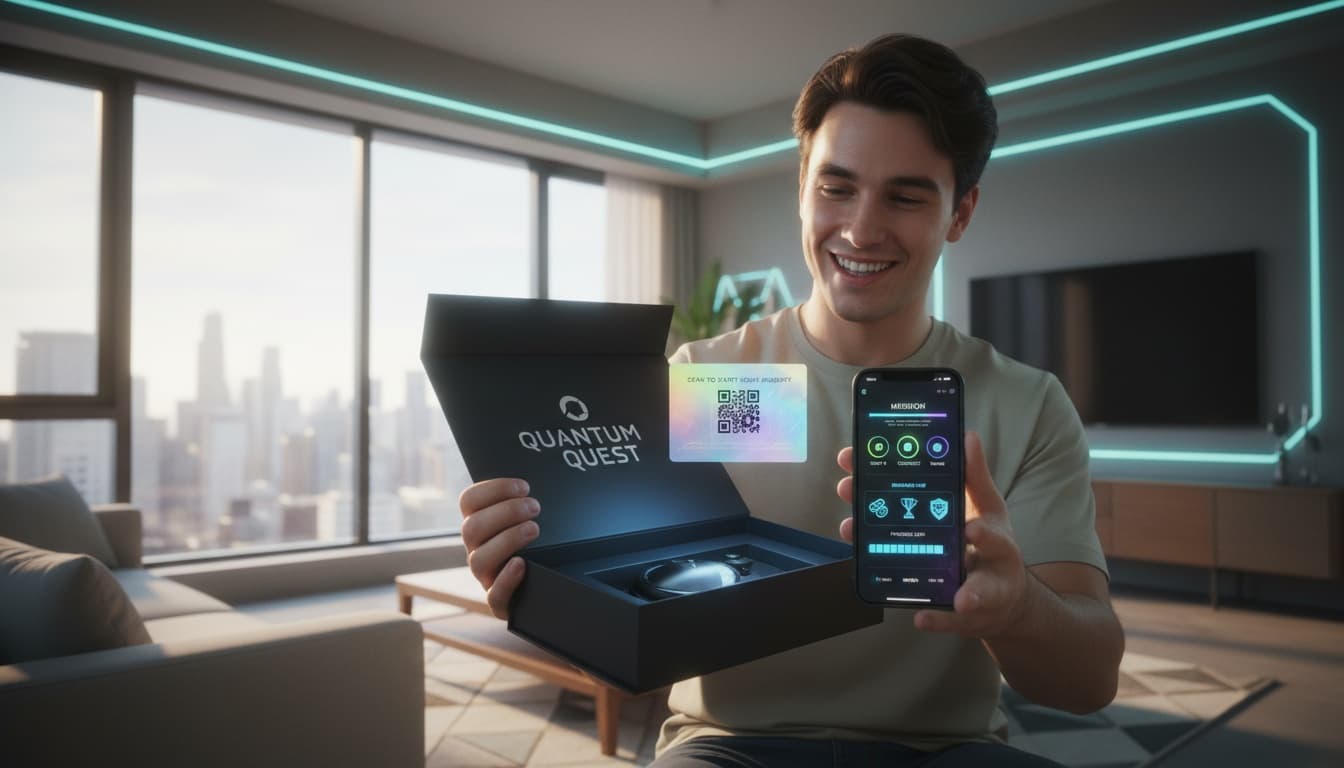Most brands spend most of their budget convincing people to buy for the first time, then treat the post purchase phase as a logistics formality. That is a mistake. The period after a customer buys is one of the most valuable windows for building loyalty, shortening the time to the next purchase, and turning a single transaction into a long term relationship. Post purchase marketing is where you turn buyers into repeat customers.
This guide shows how to design post purchase marketing that actually drives revenue. You will see how to use emotional triggers, onboarding sequences, packaging experiences, QR based missions, replenishment flows, personalized email and SMS journeys, loyalty boosters, and reorder incentives to reduce time between purchases and increase lifetime value.
Turn every order into the start of a loyalty journey
Use QR missions, smart flows, and rewards to transform your post purchase experience into a repeat purchase engine.
Why post purchase marketing matters
Acquisition costs continue to rise in every major channel. At the same time, many categories are saturated with similar offers, fast shipping, and free returns. Competing only on acquisition and price is not sustainable. Post purchase marketing helps you differentiate where competitors are often silent, after the payment is complete.
Studies on retention consistently show that even small improvements in repeat purchase behavior can dramatically increase profitability. When you reduce the time between purchases and increase the number of orders per customer, you generate more revenue without paying for new clicks every time. Post purchase marketing also improves customer satisfaction, because it focuses on guidance, support, and value instead of just pushing more offers.
Think of post purchase marketing as a sequence of designed moments: order confirmation, shipping updates, delivery, unboxing, first use, routine building, and replenishment. Each moment can be a dead end or a chance to deepen the relationship.
Emotional triggers that shape the post purchase journey
Emotions drive repeat purchases as much as logic. After buying, customers often feel excitement, anticipation, and a bit of anxiety. They hope they made the right decision. If something goes wrong in this phase, such as unclear communication or a confusing product, they may not return even if the product itself is adequate.
Effective post purchase marketing recognizes these emotions and works with them. Clear confirmation messages reduce anxiety. Transparent tracking reduces uncertainty. Helpful onboarding and education increase confidence. Rewarding moments such as surprise bonuses or welcome points build delight. Over time, these emotional cues associate your brand with reliability and care.
Design your flows around questions like: what does the customer worry about right now, what would reassure them, and what small win can we give them at this moment. This mindset keeps your campaigns human instead of purely transactional.
Onboarding sequences that reduce friction
Onboarding is the bridge between buying the product and successfully using it. A strong onboarding sequence answers three questions quickly: what should I do first, what does success look like, and where do I go if I need help. If your onboarding fails, customers may churn even if they liked the brand and marketing.
Onboarding sequences typically start right after purchase and continue through delivery and first use. They can include confirmation emails, setup guides, video walkthroughs, and habit building tips. For complex products, consider multi step onboarding over several days. For simpler items, a single clear guide might be enough.
Use your post purchase emails and SMS messages to deliver this value. Segment content based on product and customer knowledge. New customers may need more hand holding, while experienced buyers may prefer quick reminders and new ideas on how to get more out of the product.
Packaging experience as a marketing channel
Packaging is often the first physical contact customers have with your brand. It is more than protection for the product. Thoughtful packaging confirms that the brand is careful and intentional. Simple details such as clear messaging, organized layouts, and a small thank you element can improve the perceived value of the entire purchase.
Use the inside of the box and inserts as part of your post purchase marketing. Explain next steps in plain language. Highlight where to find help, how to join your loyalty program, and what customers can unlock by scanning QR codes. Avoid cramming everything into tiny print. Instead, make one or two paths obvious and rewarding.
When packaging elements are connected to digital experiences through QR codes, they become reusable entry points for onboarding, missions, and reorders instead of one time printed messages.
QR based missions that start at unboxing
QR codes turn packaging into the first step of a mission. When customers scan a code during unboxing, they can join a game like journey that rewards them for exploring content, using the product, and coming back to buy again. Missions might include actions such as watch the setup video, complete a routine, share feedback, or try a complementary product.
Each mission can grant points, badges, or unlock special offers. Because the mission starts from the physical product, it feels relevant rather than random. Tools like VISU QR Ads make it possible to connect each scan to a specific product, campaign, or creative while tracking how missions affect repeat purchases.
Over time, customers learn that each new order comes with its own set of missions and surprises. This makes unboxing more engaging and gives customers reasons to return to your brand ecosystem between purchases.

Replenishment flows and time based triggers
For consumable products, one of the strongest goals of post purchase marketing is to reduce the time between purchases without making customers feel pressured. Replenishment flows use estimated usage cycles and behavior data to trigger reminders at the right moment.
Start by defining how long an average unit lasts with typical usage, such as thirty days for supplements, six weeks for skincare, or two months for coffee. Use these assumptions to schedule reminders. Then refine timing based on real order history and engagement signals. Customers who reorder early may receive slower reminders, while those who often run out may appreciate earlier prompts.
You can link replenishment logic to QR scans from packaging using retail engagement solutions. When customers scan a code at first use, you capture a starting point. Later, reminders can reference that moment and lead to one click reorder pages, reducing friction and increasing repeat purchase rates.

Personalized email journeys after purchase
Email remains one of the most flexible channels for post purchase marketing. Instead of sending a single order confirmation and generic newsletters, build structured journeys that adapt based on product, behavior, and segment.
A typical post purchase email series can include order confirmation, shipping updates, first use guide, review request, cross sell suggestions, and replenishment reminders. Each message should have a clear purpose and build on the previous one. For example, do not ask for a review before the customer has received or used the product.
Use behavioral triggers to adjust content. If a customer opens onboarding emails but has not clicked, send a simplified version. If they have viewed specific products since the last order, highlight relevant cross sells. If they ignore several messages, reduce frequency or test a different angle such as education or community instead of direct offers.
SMS and push notifications for high impact moments
SMS and push notifications are high attention channels. They should be used for time sensitive or high importance events instead of every routine message. In the post purchase journey, SMS is ideal for shipping updates, delivery confirmations, urgent replenishment reminders, and exclusive time limited offers.
Keep messages concise and personal. Always include a clear call to action and an easy way to manage preferences. Coordinate SMS with email so customers do not receive the same message in both channels simultaneously. Use each channel for what it does best. Email can carry detailed content and visuals, while SMS can deliver quick prompts framed around convenience.
When combined with QR codes on packaging, SMS can drive customers back to specific scan based experiences, such as finish your mission by scanning the code inside your last order. This closes the loop between digital notifications and physical products.
Loyalty boosters and tier progression
Loyalty programs turn individual orders into a visible journey. After a purchase, customers should clearly see how their action affected their status. This is especially important in the post purchase window, where customers are still emotionally engaged.
Send post purchase messages that show how many points were earned, how close the customer is to the next reward, and what benefits will unlock at the next tier. These small updates act as loyalty boosters, reminding customers that their choice had long term benefits.
You can also design specific boosters such as double points on the next order within a certain window, bonus rewards for scanning a QR code on packaging, or missions that accelerate tier progression. These mechanics give customers reasons to return sooner without resorting to permanent discounts.
Reorder incentives that respect value and margin
Reorder incentives are offers designed specifically for returning purchases. They should encourage the next order while protecting margins. Heavy blanket discounts may increase volume but erode profitability and train customers to wait for deals. Smarter incentives use targeted value and clear conditions.
Examples include small credits for reordering within a certain time frame, loyalty points multipliers, free shipping thresholds, or free samples with the next order. You can also offer bundles that reward larger reorders while making sense for the customer, such as a three pack priced below individual units but aligned with realistic usage.
Link reorder incentives to data. High value segments may receive different offers than one time buyers. Customers who often respond to content about quality or sustainability might appreciate experiential rewards, such as donate points to a cause, more than straightforward discounts.
Reducing time between purchases: a practical playbook
Reducing time between purchases is one of the clearest signs that post purchase marketing is working. Here is a practical playbook you can adapt:
First, map your current time between orders by category and segment. Identify averages and outliers. Second, design onboarding, education, and replenishment flows tailored to your main products. Third, add QR based triggers on packaging to capture first use moments and send customers to guided journeys.
Fourth, introduce loyalty boosters and reorder incentives that reward timely repeat purchases. Fifth, test different timing windows for reminders and offers. Compare cohorts that receive campaigns at different intervals. Finally, track whether new cohorts show shorter reorder cycles and higher lifetime value than past cohorts.
Do not try to compress time between purchases beyond what is natural for your category. If customers feel pressured to buy again before they need the product, they may churn. The goal is to be present and helpful at the right moment, not to force urgency where it does not belong.
Build a post purchase engine that keeps customers coming back
Combine QR missions, smart replenishment flows, and loyalty boosters to turn every order into the beginning of a long term relationship.

